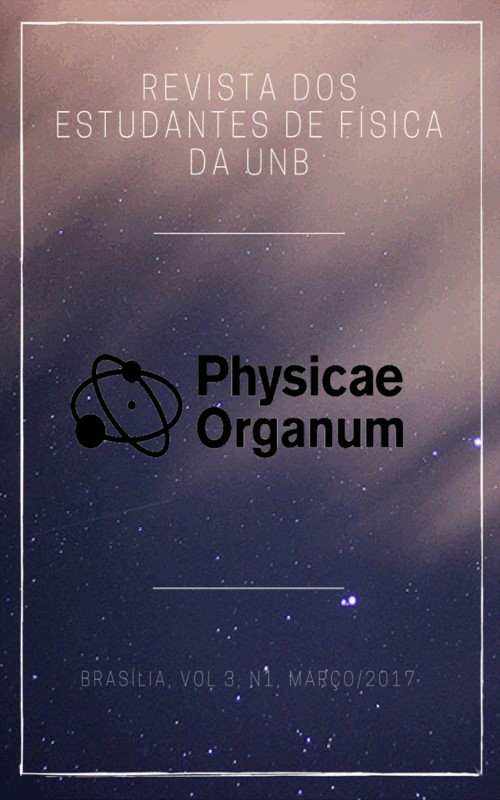Um catálogo unificado para os Gamma-ray Bursts
Mots-clés :
Astrofísica de altas energias. Gamma-ray Burts. Análise de catálogos de objetos.Résumé
Os Gamma-ray Bursts são eventos transientes de altíssima energia. Possivelmente têm como origem dois tipos de fenômenos: o colapso gravitacional de estrelas de grande massa; ou a coalescência de estrelas compactas. Ocorrem entre 300 e 400 destes eventos ao ano, distribuídos uniformemente no céu e também, em termos de distância, acompanham a taxa de formação estelar já bem conhecida. Neste trabalho serão apresentadas as características gerais destes fenômenos obtidas durante a produção de um catálogo de eventos bastante abrangente, que ficará disponível para uso de toda a comunidade científica.
Téléchargements
Références
Appendix g to the nasa research announcement for the compton gamma ray observatory guest investigator program. http://heasarc.gsfc.nasa.gov/docs/cgro/nra/appendix_g.html. Accessado:/07/2016.
Swift’s burst alert telescope (bat). http://swift.gsfc.nasa.gov/about_swift/bat_desc.html. Accessado: 11/07/2016.
Swift’s ultraviolet/optical telescope (uvot). http://swift.gsfc.nasa.gov/about_swift/uvot_desc.html. Accessado: 11/07/2016.
Swift’s x-ray telescope (xrt). http://swift.gsfc.nasa.gov/about_swift/xrt_desc.html. Acessado: 11/07/2016.
B. P. Abbott and et al. Observation of Gravitational Waves from a Binary Black Hole Merger. Physical Review Letters, 116(6):061102, February 2016.
M. Ackermann and et al. Fermi-LAT Observations of the Gamma-Ray Burst GRB 130427A. Science, 343:42”“47, January 2014.
Lorenzo Amati. The bepposax gamma-ray burst monitor response matrix and its application to the study of cosmic gamma-ray bursts. Università di Roma"La Sapienza", Dottorato di Ricerca in Astronomia, 1999.
W. B. Atwood and et al. The Large Area Telescope on the Fermi Gamma-Ray Space Telescope Mission. The Astrophysical Journal, 697:1071”“1102, June 2009.
A. Bernui, I. S. Ferreira, and C. A. Wuensche. On the Large-Scale Angular Distribution of Short Gamma-Ray Bursts. The Astrophysical Journal, 673:968”“971, February 2008.
P Narayana Bhat and et al. The third fermi gbm gamma-ray burst catalog: the first six years. The Astrophysical Journal Supplement Series, 223(2):28, 2016.
Joshua S Bloom. What are gamma-ray bursts? Princeton University Press, 2011.
W. R. Brown, M. J. Geller, S. J. Kenyon, and M. J. Kurtz. Discovery of an Unbound Hypervelocity Star in the Milky Way Halo. The Astrophysical Journal, 622:L33”“L36, March 2005.
V. Connaughton and et al. Fermi GBM Observations of LIGO Gravitational Wave event GW150914. ArXiv e-prints, February 2016.
Carl Eugene Crouthamel, Freddy Adams, and Richard Dams. Applied gamma-ray spectrometry. Pergamon Press, 1975.
M. Galli and et al. AGILE mini-calorimeter gamma-ray burst catalog. Astronomy & Astrophysics, 553:A33, May 2013.
Elizabeth Howell. What is a wolf-rayet star? http://www.universetoday.com/24736/wolf-rayet-star/. Accessado: 11/07/2016.
C. Kouveliotou and et al. Correlations between duration, hardness and intensity in GRBs. In C. Kouveliotou, M. F. Briggs, and G. J. Fishman, editors, American Institute of Physics Conference Series, volume 384 of American Institute of Physics Conference Series, pages 42”“46, August 1996.
Chryssa Kouveliotou, Charles A Meegan, Gerald J Fishman, Narayana P Bhat, Michael S Briggs, Thomas M Koshut, William S Paciesas, and Geoffrey N Pendleton. Identification of two classes of gamma-ray bursts. The Astrophysical Journal, 413:L101”“L104, 1993.
Helmuth Spieler. Semiconductor detector systems, volume 12. Oxford university press, 2005.
M. Tavani and et al. The AGILE Mission. Astronomy & Astrophysics, 502:995”“1013, August 2009.
Gilbert Vedrenne and Jean-Luc Atteia. Gamma-ray bursts: the brightest explosions in the universe. Springer & Praxis Publishing Ltd, 2009.
Téléchargements
Publié-e
Comment citer
Numéro
Rubrique
Licence
Autores que publicam nesta revista concordam com os seguintes termos:
Autores mantém os direitos autorais e concedem à revista o direito de primeira publicação, sendo o trabalho simultaneamente licenciado sob a Creative Commons Attribution License o que permite o compartilhamento do trabalho com reconhecimento da autoria do trabalho e publicação inicial nesta revista.
Autores têm autorização para assumir contratos adicionais separadamente, para distribuição não-exclusiva da versão do trabalho publicada nesta revista (ex.: publicar em repositório institucional ou como capítulo de livro), com reconhecimento de autoria e publicação inicial nesta revista.
Autores têm permissão e são estimulados a publicar e distribuir seu trabalho online (ex.: em repositórios institucionais ou na sua página pessoal) a qualquer ponto antes ou durante o processo editorial, já que isso pode gerar alterações produtivas, bem como aumentar o impacto e a citação do trabalho publicado (Veja O Efeito do Acesso Livre).




